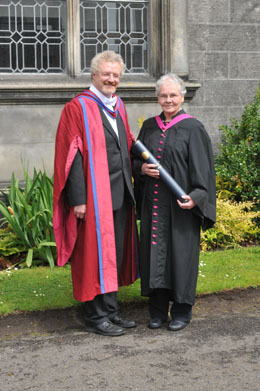Laureation address – Dr Christiane Nüsslein-Volhard
Dr Christiane Nüsslein-Volhard
Honorary Degree of Doctor of Science
Laureation by Professor Garry Taylor
School of Biology
Wednesday 22 June 2011

Vice-Chancellor, it is my privilege to present Dr Christiane Nüsslein-Volhard, winner of the Nobel Prize in Physiology or Medicine, for the degree of Doctor of Science, honoris causa.
One of the marvels of life is the way that an egg, a simple single cell, develops into a fly, a chicken or a human being. How do dividing cells in a growing embryo, that initially look identical, suddenly decide to form an eye, an ear or a leg? Christiane Nüsslein-Volhard, together with Edward Lewis and Eric Wieschaus, was awarded the Nobel prize in 1995 for discovering how genes control the early development of the embryo.
Christiane was born in Magdeburg, Germany in 1942. From an early age she possessed an intense curiosity about many things, read books avidly and by the age of 12 knew that she wanted to be a biologist. She admits that she left school with a mediocre exam mark, however her perceptive teachers wrote in a school report: “she is gifted above average, has a critical and qualified judgement, and the talent for independent scientific work”. Christiane went to Tübingen to study what was then a new degree in biochemistry. Her PhD, also at Tübingen, focused on understanding the structure of a promoter region used in DNA replication. She graduated as an experienced molecular biologist, but somewhat bored with her thesis projects. Happily, the Max Planck Institutes in Tübingen provided an intellectual environment that sparked Christiane’s interest in developmental biology. Influenced by the writings of Alfred Kuhn, and the work of Friedrich Bonhoeffer in Tübingen, she saw the power of analysing mutations in DNA that could give rise to perceptible changes in the development of the embryo. Such mutations might allow the discovery of genes that control the development of the growing organism.
Christiane decided that the fruit fly, whose scientific name is Drosophila melanogaster, was the ideal model to study. Some early work on Drosophila mutants had been described, and the fruit fly had several technical advantages. She moved to the laboratory of Walter Gehring in Basel in 1975 to study Drosophila mutants, and there met Eric Wieschaus. In 1978 both Christiane and Eric were offered group leader positions at the newly formed European Molecular Biology Laboratory in Heidelberg, where they established a small lab working on Drosophila mutants. Remember, that this was before recombinant DNA technology had been established, and well before the sequencing of complete genomes. The larva of a fruit fly is a small maggot with a distinct banding pattern, with features that define its top and bottom, and its front and back. The experiments they performed involved chemically inducing mutations in the DNA of male flies, breeding them with females, and examining any resultant changes in the larvae of progeny flies. Mutations were traced to specific locations on the fly’s chromosomes, and thereby linkages were made between mutations in a particular gene, or genes, and a resulting change in embryonic development. Such phenotypic changes were given names such as hunchback, hedgehog and gooseberry, reflecting the shape and form of the mutant embryo. After an heroic amount of work, developing new techniques, breeding flies, looking at thousands of mutants and examining their chromosomes, Christiane and Eric published their seminal paper in Nature in 1980 describing the genes involved in forming the banded, or segmented pattern of the fruit fly larva.
Subsequent molecular genetics revealed the surprisingly widespread conservation of the genes that Christiane discovered, controlling the development of the embryo, be it a fly or an elephant. Some of these genes encode transcription factors, proteins that switch on or off the expression of other genes, others are proteins that bind to the cell surface and trigger signals that pass to the nucleus of a cell. Together these genes orchestrate the complex events of cellular differentiation of the developing animal.
In 1981 Christiane moved to the Friedrich Miescher Laboratory in Tübingen, continuing her research on Drosophila as well as the zebrafish as a model for vertebrate development. She was appointed Director of the Max-Planck Institute for Developmental Biology in 1985, a position she still holds. She has received several awards in addition to her Nobel Prize, including the Albert Lasker award for Basic Medical Research and the Leibnitz Prize, the highest honour in German science. She also has an asteroid named after her!
In 2004, she established a foundation in her name that provides financial support to young female German scientists to assist with childcare and domestic chores. She was inspired by one of her graduate students who considered dropping out of science to care for her child. Such a simple, practical measure will encourage more women to stay in science and help redress the obvious gender imbalance that exists at the top of science.
Goethe said: “The credit of advancing science has always been due to individuals and never to the age”. Today we honor a remarkable individual whose work will have a huge impact on our understanding of human biology for ages to come.
Vice-Chancellor, in recognition of her major contribution to understanding how the egg develops into an animal, I invite you to confer on Christiane Nüsslein-Volhard the degree of Doctor of Science, honoris causa.
Category Awards